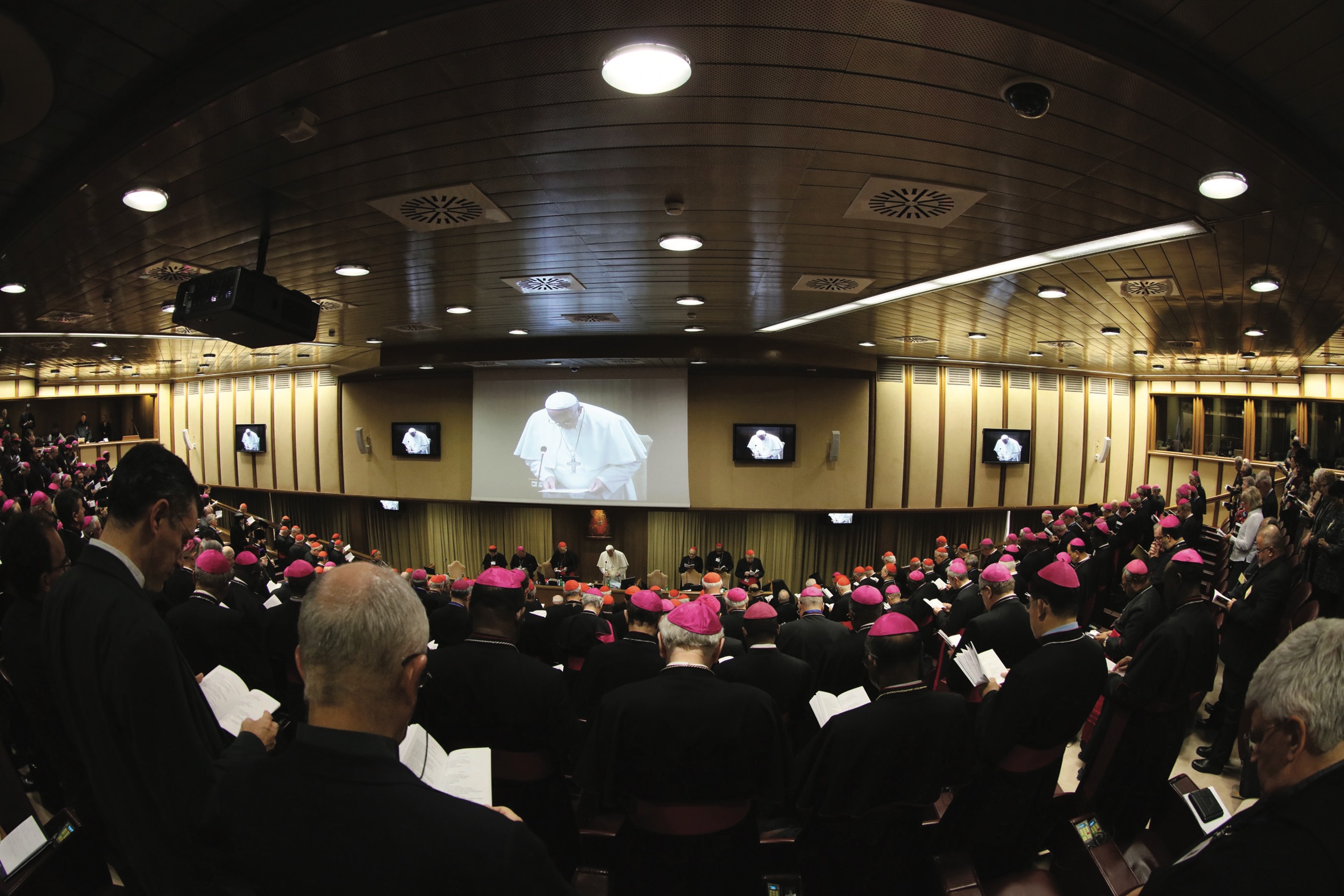
This photo is from October 15, at the mid-point of the Synod. Pope Francis leads the Synod in prayer before the day’s session gets underway (Galazka photo).
Our special correspondent, Mary Jo Anderson, an American Catholic woman writer, spent most of October in Rome. These are passages from her “Synod journal”
The much-reported Synod on the Family concluded in Rome five days ago. In both secular and Catholic publications, the meeting of bishops from every nation was framed as a battle. Pope Francis himself warned the world’s cardinals and bishops to resist the “Hermeneutic of Conspiracy.” That is a phrase that commands a journalist’s attention. It has claimed mine for the past two weeks.
Though prelates have returned to their continents, verbal skirmishes continue. To be sure, several bishops have praised the consensus that was achieved during the three-week gathering, but, that is diplomacy speaking.
The stakes are high. Some defend the “ever ancient, ever new” Church while others push a “new Church” retrofitted with greater mercy for the “new realities” of contemporary life. During a two-year process of back-to-back synods on the family, headlines described the proceedings as filled with “cabals,” “manipulation,” “suspicion,” “secret letters” and “clashes.” On Sunday at the closing Mass of the Ordinary Synod, my overwhelming thought was, “There is no clear sense of the way forward.”
Progressives, largely led by some European conferences, claim a victory for openness toward the divorced and remarried, and toward same-sex pairs in the call for pastoral “accompaniment.” They believe Pope Francis has emphasized mercy over “legalism” as the theme of his papacy. Cardinal Donald Wuerl of Washington, D.C., in response to how “accompaniment” would apply, said, “The frame of reference now is no longer the Code of Canon Law… I think the Holy Father has a whole range of opportunities before him. I think we just have to wait and see what he chooses.”
Critics see “accompaniment” as an ambiguous term open to interpretations not supported by Catholic doctrine. Orthodox Catholics believe they have held the line because there is no rupture between proposed pastoral paths and doctrinal teachings in the Relatio Finalis, the final document produced by the Synod and formally presented to the Pope.
The Relatio Finalis is itself a major achievement. The bishops began with an Instrumentum Laboris, or working document, of suspect sociology drafted by a small committee with distinctly modernist goals. Bishops had little patience with the pessimistic, ideological Instrumentum that was nearly devoid of biblical references. Three weeks later the prelates had transformed the document into their own Relatio filled with Scripture, magisterial writings and praise for Catholic families whose lives reflect the Gospel.
If the world’s orthodox bishops, led by Africa, America and Eastern Europe, managed to guard key doctrinal points, the Holy Father’s own closing address appeared to scold the guardians of doctrine:
It [the Synod] was also about laying bare the closed hearts which frequently hide even behind the Church’s teachings or good intentions, in order to sit in the chair of Moses and judge, sometimes with superiority and superficiality, difficult cases and wounded families… It was about trying to open up broader horizons, rising above conspiracy theories and blinkered viewpoints, so as to defend and spread the freedom of the children of God, and to transmit the beauty of Christian newness, at times encrusted in a language which is archaic or simply incomprehensible… Dear Brothers, the Synod experience also made us better realize that the true defenders of doctrine are not those who uphold its letter, but its spirit; not ideas but people; not formulae but the gratuitousness of God’s love and forgiveness. This is in no way to detract from the importance of formulae, laws and divine commandments…
The closing statement left many people off-balance as regards the true desires of Pope Francis.
Some have suggested that any pastoral flexibility (such as Communion for the divorced and remarried) not approved in the final document would have to be explicitly added back in the Pope’s post-Synod exhortation, assuming that is his desire. This presents a thorny problem for the Holy Father. To reintroduce specific pastoral proposals that were rejected (twice) by the Synod Fathers makes a mockery of the very synodality, the collegiality, that Pope Francis hoped to achieve. It is not the same in reverse: To use papal authority to inject doctrinal stability where it is lacking is part of the Petrine ministry.
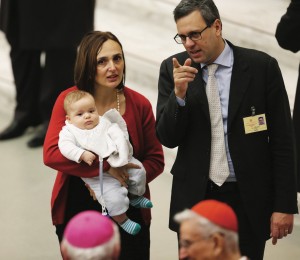
Three lay people who participated in the Synod: Massimo Paloni, his wife Patrizia Calabrese… and their son David (Galazka photo).
Many have wondered where the Holy Father intends the work of the Synod to lead. Some observed that while the subject of this Synod was the family, the goal was to advance the process of synodality and to build sufficient trust among the bishops that they might speak their minds without fear of opprobrium — and trust that the Holy Spirit will sort it all out. Pope Francis has said definitively that marriage is for man and woman. He has stressed the importance of the family. Some speculate that his doctrinal position is traditional, but his open, expansive Latin style sacrifices clear teaching and has caused considerable confusion.
Will Pope Francis issue a post-Synod document, as is tradition? When I departed Rome, that was still unknown. The Pope had reserved the option of simply accepting the Synod’s document as an advisory consultation. Archbishop Joseph Kurtz, president of the United States Conference of Catholic Bishops, expressed his hope that the Holy Father would issue an apostolic exhortation.
“I do think that there are enough questions — as opposed to answers — that come through the document that we would benefit by some direction from our Holy Father,” he said. Until yesterday, a post-Synod exhortation was uncertain; today Cardinal Pietro Parolin, Vatican Secretary of State, announced that Pope Francis would issue an apostolic exhortation in the coming months. Until that exhortation is written, the Church cannot know how the work of the Synod will influence the years ahead. Inevitably, there is speculation about what the exhortation will hold.
I slide stacks of official Bollettinos from my luggage, the daily bulletins meticulously gathered each day at noon in the Vatican Press Office before the daily briefing to journalists — remnants from my two weeks of reporting on the Synod. These bulletins serve as a chronicle of the zigzagged paths the Synod sessions followed — first “yes” then “no,” then “maybe in special cases.”
There is also a sheaf of comments from blogsites and Twitter. Perhaps, for the first time in history, we have had the phenomenon of archbishops and cardinals who openly circumvented the official Vatican channels of communication. When both the Sala Stampa (Vatican Press Office) and the media fixated on “irregular unions” to the exclusion of the struggles of regular families, New York’s Cardinal Dolan expressed a concern for a “New Minority” on his personal blog. Bishops took to social media to tell the world what was really happening inside the Synod hall, rather than permit the media to drive public perception. This is a result of the distrust that began during last year’s preliminary Synod. Many bishops arrived in Rome this year alert to the machinations that marred the Extraordinary Synod last October.
The events of this year cannot be understood apart from that preceding Synod in 2014. It was cast as the “Tale of Two Synods,” the Synod of Bishops and the Synod of the Media. So much deliberate misinformation was released to the press last year that Cardinal Napier of Durban, South Africa, told reporters that everything the bishops did from that point forward would be seen by the world as “damage control.”
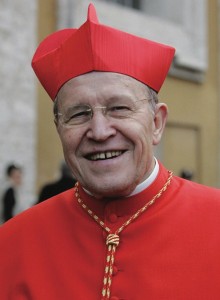
Cardinal Kasper, leader of the “progressives.”

Cardinal Napier, a leader of the more “conservative” Africans.
Then, as well as this year, segments of the media sought to drive the public perception of what the Church should do regarding “irregular relationships.” The situation is reminiscent of 1968 when the world awaited the decision of Pope Paul VI on artificial means of birth control. Various commercial and social interests built an expectation in the public mind that the Church “must” approve use of “the pill.” Today, in a similar manner, the popular press, joined by liberal Catholic publications, attempt to frame the discussion on the family as a discussion about divorced and remarried Catholics, homosexual Catholics and cohabiting Catholics who should not be “marginalized” by pastors and parishes.
How, why and by whom so much misinformation was released to the public continued to disturb observant Catholics and bishops. Just before the Ordinary Synod opened this October, an explosive book was released by veteran Vatican journalist Edward Pentin, The Rigging of a Vatican Synod?
Thus, this year, bishops arrived in Rome better prepared to inform their flock about the true works in progress inside the Synod Aula (hall). The uncomfortable conclusion is that the two successive Synods on the Family revealed a serious fissure within the family of the Church. The repeated calls by the Pope for his bishops to “journey together” is evidence that not all would take the same road into the future. The hierarchy is roughly divided into two groups, those with fidelity to the deposit of faith clashing with those who urge a more contemporary formulation of Catholicism. The press naturally favors the latter and clearly promotes the “Kasper Proposal.”
Most Catholics who have followed the reports on the Synods have heard the term “The Kasper Proposal,” named for German Cardinal Walter Kasper. The proposal advocates a “path” for divorced and remarried Catholics to be readmitted to Communion. The African prelates had been vocal in their opposition to the proposal in 2014. How can there be a path toward Communion unless there is conversion? The very teaching of Jesus Himself is the source for Catholic doctrine on the indissolubility of marriage — any remarriage is adultery (Mt. 19:4-8). The Africans refused to compromise. A frustrated Cardinal Kasper shocked Vatican watchers last October when he told Edward Pentin that the African cardinals “should not tell us too much what we have to do.” When he denied his ungracious remark and threatened the reporter’s job, Pentin produced the audio tape which confirmed the cardinal had said precisely that — and more.
Such shenanigans may have provoked papal ire, but if so it was private. Pope Francis and Cardinal Kasper are reported to be close; the Holy Father had invited Cardinal Kasper to give a presentation on his proposal to the February 2014 consistory. Presumably, this is why Cardinal Kasper was so bold — he felt his proposal had the support of the Pope himself. One possible response from the Pope following the remarks by Cardinal Kasper was to place Cardinal Napier of South Africa on the drafting committee for the final report of Extraordinary (preliminary) Synod.
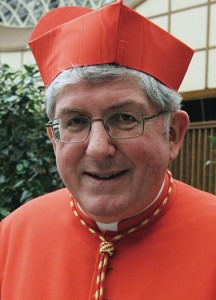
Cardinal Thomas Collins of Toronto, Canada.
However, the interim report of the 2014 synod had been clumsy, inaccurate and, some say, manipulated by progressive prelates who sat on the drafting committee. Cardinal Napier had been publicly critical of that mid-term relatio. It may be the Holy Father placed Napier on the drafting committee, not as a balm for Cardinal Kasper’s indelicate comment, but to offer Cardinal Napier an opportunity to balance the committee as the Synod moved toward a final document.
That final document from the preliminary synod was put to a vote of the entire assembly (last year, in 2014). They voted out the three paragraphs that addressed Communion for the divorced and civilly remarried, cohabiting couples and same-sex pairs. However, Pope Francis asked that the failed paragraphs be retained as footnotes.
It is against that background that several crucial books were published in the months between the synods, leading up to the Ordinary Synod of 2015: not only Rigging, but also Cardinal Robert Sarah’s God or Nothing and Eleven Cardinals Speak on Marriage and Family. At this juncture it’s not possible to know how much influence these volumes had on the bishops. But the comparison of this year’s Synod to last year’s is a remarkable contrast. This year, orthodoxy firmly stood its ground. However, if no ground was lost, none was gained. Few would offer prophecy about the direction the Church will take in the next few years. There is a hermeneutic of ambiguity clouding the horizon.
Several stacks of documents cover my desk. In the months ahead the “cracks” that have been opened during this two-synod process will surely be examined in the Catholic press. Key topics that were raised in the synods that journalists will tackle in the coming months include “decentralization” vs. the universality of the Church, Humanae Vitae for modern marriages, and the role of individual conscience in pastoral counseling.
I organize the stacks of bulletins and reflect on what lies ahead. As important as these topics may be, it seems that what the darkened world, besotted with secular individualism, needs most is the witness of healthy families. The Church must avoid any ambiguity that construes “accommodation” as affirming persons in their error. Confusion is dispelled by truth. I am persuaded by Cardinal Thomas Collins of Toronto, who offered this insight at the Synod: “We are called to accompany people with a compassion that challenges, and that leads to conversion, and to a heart on fire for Christ. Pastors, who must daily accompany their people in their struggles, should imitate Jesus on the road to Emmaus, and with clarity and charity preach the call to conversion, which is the foundation for the liberating message of Jesus, ‘Repent, for the kingdom of heaven is at hand’ (Matthew 4:17).”

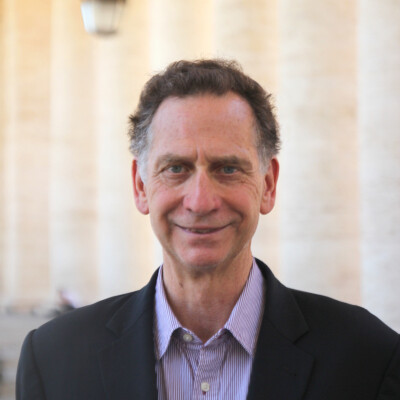

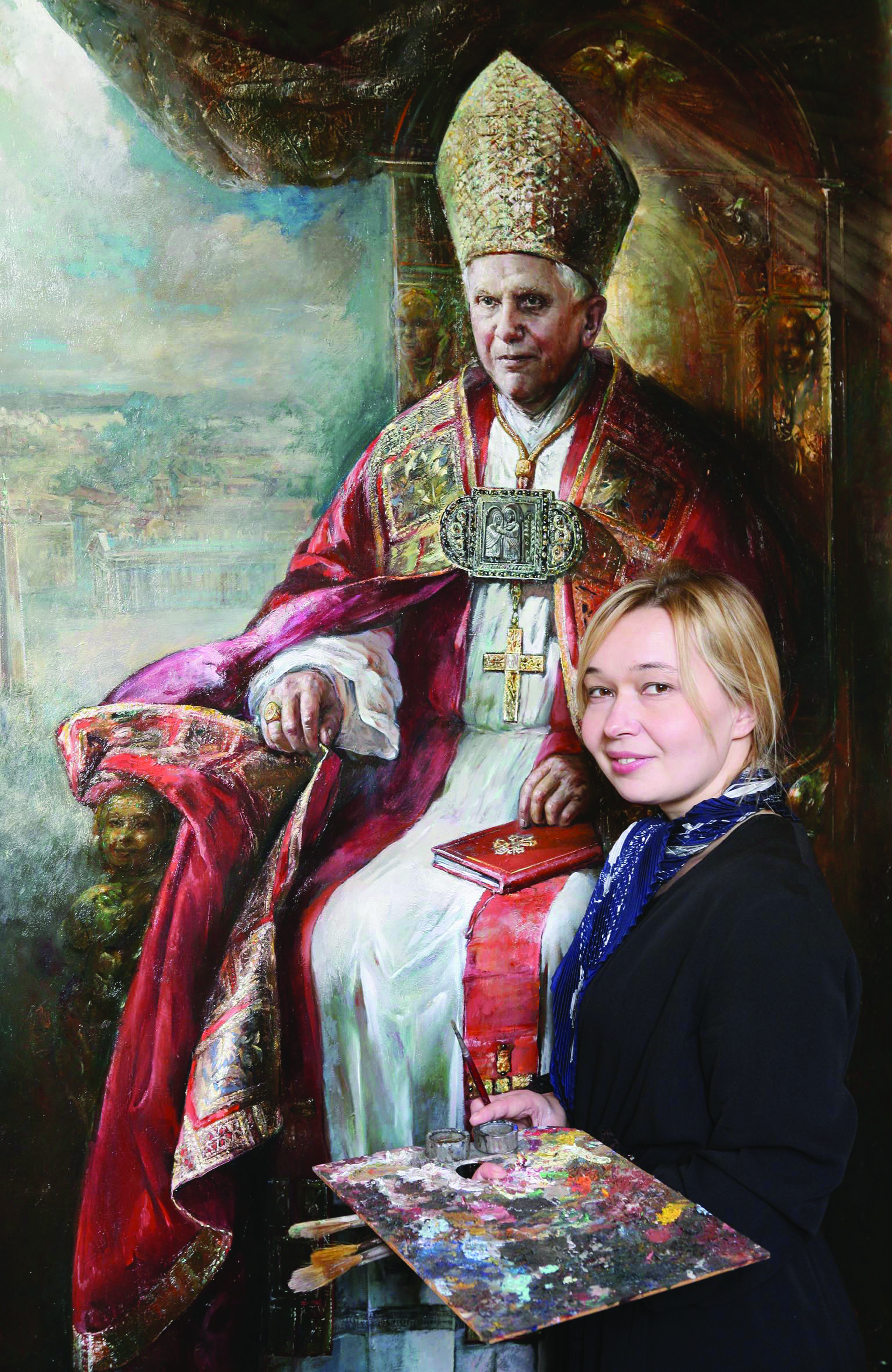
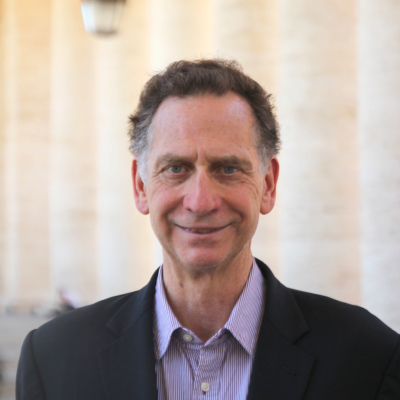
Facebook Comments